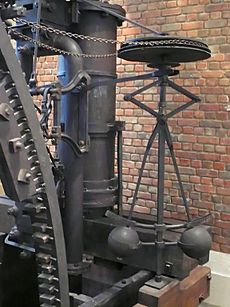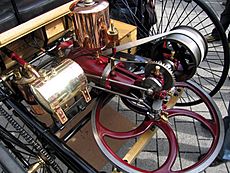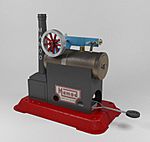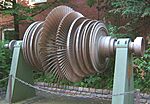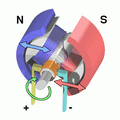Engine facts for kids
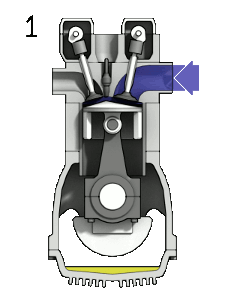
- Induction (Fuel enters)
- Compression
- Ignition (Fuel is burnt)
- Emission (Exhaust out)
An engine or motor is a machine that changes different types of energy into movement. This movement can then be used to do work. The energy can come from many sources. Common energy sources for engines include electricity, chemicals (like petrol or diesel), or heat. When a chemical is used to create energy, it is called fuel.
The words engine and motor are often used to mean the same thing, but there's a small difference. An engine usually creates mechanical energy from heat, like a steam engine or an internal combustion engine. A motor, on the other hand, creates mechanical energy from other types of energy, such as electricity or hydraulics.
Contents
What is an Engine?
The word "engine" originally meant any machine that turned force into motion. For example, old weapons like catapults were called "siege engines." The word "gin," as in "cotton gin," is actually a short form of "engine." It comes from an old French word meaning "clever invention."
Today, the term engine mostly refers to heat engines. These engines burn or use fuel to create movement. They produce a turning force (called torque) or a pushing force (called thrust). Car engines, which use petrol or diesel, are examples of engines that create torque. Jet engines and rockets are examples of engines that create thrust.
A Brief History of Engines
Engines have been around for a very long time!
Early Simple Machines
Long ago, people used simple tools like clubs and oars. These were early examples of how humans used basic machines to make tasks easier. More complex machines that used human, animal, water, or wind power appeared in ancient times.
People used simple engines like the capstan or windlass to multiply their strength. These were used with ropes and pulleys to lift heavy things or move ships. Ancient Greeks and Romans used these machines in cranes, on ships, in mines, and for pumping water. Writers from those times, like Vitruvius, wrote about these engines as if they were common.
By the 1st century AD, animals like cattle and horses were used to power mills. These mills used machines similar to those powered by humans before.
Water and Wind Power
Water-powered mills spread across the Roman Empire over several centuries. Some were very advanced, with aqueducts, dams, and sluices to control the water. They also had gears (toothed-wheels) made of wood and metal to change the speed.
Small, clever devices like the Antikythera mechanism used complex gears to act as calendars or predict events in space. In the 4th century AD, a writer named Ausonius mentioned a saw for cutting stone that was powered by water. Hero of Alexandria, around the 1st century AD, created many machines powered by wind and steam, including the Aeolipile (a spinning steam ball).
Medieval Innovations
During the Islamic Golden Age, Muslim engineers used gears in mills and machines that lifted water. They also used dams to create more water power for these machines. These inventions helped to automate many tasks that used to be done by hand.
In 1206, a brilliant engineer named al-Jazari used a special crank-rod system in his water-lifting machines. Later, in the 16th and 17th centuries, people like Taqi al-Din and Giovanni Branca described early steam turbine devices.
The rocket motor was invented in China in the 13th century. It used gunpowder to create a powerful burst of thrust. While it couldn't provide continuous power, it was great for launching weapons and fireworks. This invention soon spread to Europe.
The Industrial Revolution Begins
The Watt steam engine was a huge step forward. It improved on earlier designs and used steam to push a piston and create motion. James Watt developed this engine between 1763 and 1775. It used much less fuel than previous engines.
Watt's engine became very popular, partly thanks to his business partner, Matthew Boulton. It allowed factories to grow rapidly and become more automated, even in places without water power. Later, this led to the invention of steam locomotives and the expansion of railway transportation.
Meanwhile, people were also working on internal combustion engines, which burn fuel inside the engine itself. Early versions were tested in France in 1807. In 1860, Étienne Lenoir created the first commercially successful internal combustion engine.
In 1877, the Otto cycle engine was invented. It was much lighter and more powerful than steam engines for its size. This made it perfect for new inventions like cars and aircraft.
Engines for Automobiles
The first successful car was built by Karl Benz. This made people even more interested in small, powerful engines. The lightweight petrol internal combustion engine, using the four-stroke Otto cycle, became the most common type for cars.
For larger vehicles like trucks and buses, the more efficient Diesel engine is often used. In recent years, turbo Diesel engines have also become popular for smaller cars, especially outside the United States.
Types of Engines
There are many different kinds of engines, each working in a unique way.
Piston Engines
Early engines often used heat from outside the engine to create high-pressure gas, usually steam. These are called steam engines. The steam was sent to the engine, where it pushed on pistons to create movement. Steam engines were common in old factories, boats, and trains.
Most cars today use an engine that burns fuel inside itself. This is called an internal combustion engine. There are many types of internal combustion engines, grouped by the fuel they use, how they work (their "cycle"), and how their parts are arranged. Common fuels include petrol, diesel, and alcohol.
There are different "cycles" for these engines:
- 2-stroke engines produce power once every turn of the engine.
- 4-stroke engines produce power once every two turns of the engine.
- 6-stroke engines produce power twice every six turns of the engine.
Piston engines have cylinders with pistons inside them, connected to a crankshaft. Engines can have different numbers of cylinders, like 1, 2, 3, 4, 6, 8, 10, or 12. The cylinders can be arranged in a straight line, at an angle, or in a circle.
A Wankel engine is different because it doesn't have cylinders or pistons. Instead, it uses a triangle-shaped rotor that spins inside an oval-shaped casing.
Turbine Engines
Hot gas can also be used to spin a turbine, much like wind turns a windmill. Most electric power stations use large steam turbines to generate electricity. Other turbines use water or wind.
Smaller turbines use internal combustion. Jet engines, which power aircraft, are a type of turbine engine.
Rocket Engines
A rocket moves by shooting jets of gas very quickly out of a nozzle. This gas can be stored under pressure, or it can be created by burning a chemical fuel to make very hot gas.
Even though they are simple in principle, rockets are the most powerful engines we know how to build. They can even work in space, where there's nothing for them to push against!
Electric Motors
Electric motors do not use fuel directly. Instead, they get their energy from electricity carried through wires. This electricity might come from a power plant far away that burns fuel. Inside the motor, electricity is used to create powerful magnets that switch on and off at the right time, causing the motor's shaft to spin.
It's important to know that an electric engine is usually a railway locomotive that runs on electricity, not the small motor found in many devices.
Related pages
Images for kids
-
Animation showing the four stages of the four-stroke gasoline-fueled internal combustion cycle with electrical ignition:
See also
 In Spanish: Motor para niños
In Spanish: Motor para niños


